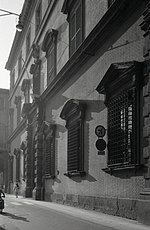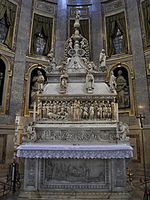Corpus Domini, Bologna

The Church of Corpus Domini, also known as the Chiesa della Santa is a Roman Catholic church in Bologna. It is part of an active monastery complex of the order of Clarissan nuns, that is nuns of the contemplative Second Order of St. Francis. The monastery is semi-cloistered. The complex hosts a museum dedicated to nurses and nursing, inaugurated by Cardinal Giorgio Gusmini in 1919. The museum has written and perhaps painted works of Saint Caterina de' Vigri, also known as Saint Catherine of Bologna (1413–1463). The church structure was built in 1478 and decorated in the 17th century, among the works are: Frescoes of a "Glory of Angels" in apse and "Evangelists" in medallions by Marcantonio Franceschini Floral decoration by Enrico Haffner Quadratura by Luigi Quaini Stucco work by Giuseppe Maria MazzaThe church allows visitors to enter an adjacent site to see and pray to the enthroned mummified corpse of the 15th-century Clarisse nun and saint, canonized in the 18th century.
Excerpt from the Wikipedia article Corpus Domini, Bologna (License: CC BY-SA 3.0, Authors, Images).Corpus Domini, Bologna
Via Tagliapietre, Bologna Malpighi
Geographical coordinates (GPS) Address External links Nearby Places Show on map
Geographical coordinates (GPS)
| Latitude | Longitude |
|---|---|
| N 44.489166666667 ° | E 11.339722222222 ° |
Address
Santuario del Corpus Domini
Via Tagliapietre 19
40123 Bologna, Malpighi
Emilia-Romagna, Italy
Open on Google Maps









